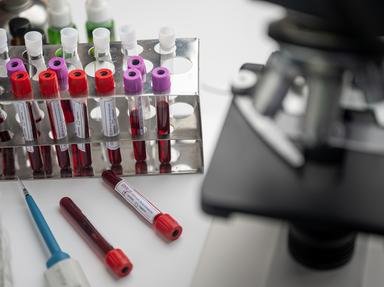Quiz Answer Key and Fun Facts
1. The simplest of all amino acids, which amino acid is represented by this R group (A=amino acid backbone):
A-H ?
2. One of two sulfur-containing amino acids, which amino acid has the following R group (A=amino acid backbone):
A-CH2-SH ?
3. Which amino acid's R group is this (A=amino acid backbone, neg=negative charge):
A-CH2-CH2-C(=O)-O(neg) ?
4. Name the amino acid, one of three alcohol (-OH) containing amino acids, that this R group is part of (A=amino acid backbone):
A-CH(CH3)-OH
5. Which unusual amino acid does this R group belong to (pos=positive charge):
A closed ring structure forming from alpha C-CH2-CH2-CH2-H2N(pos)-alpha C.
[NB: only one alpha C is present, this closes the ring. Alpha C and H2N(pos) are part of amino acid backbone.]
6. This structure represents the R group of which amino acid, which is known for its role in mutations causing sickle-cell anemia [A=amino acid backbone]:
A-CH(CH3)-CH3 ?
7. Which amino acid, first obtained from silk, has this R group [A=amino acid backbone]:
A-CH2-OH ?
8. Which amino acid, the second most commonly integrated into proteins, has this R group [A=amino acid backbone]:
A-CH3 ?
9. Which aromatic amino acid is represented by this R group (A=amino acid backbone):
A-CH2-pentagonal ring containing an NH group and double bond-hexagonal phenyl group ?
(Or A-CH2-indole ring)
[Sorry for the poor representation!]
10. Which amino acid has this R group and plays an important role in secondary structures of proteins [A=amino acid backbone]:
A-CH2-C(=O)-NH2 ?
11. Which aliphatic amino acid does this represent [A=amino acid backbone]:
A-CH2-CH(CH3)-CH3 ?
12. Which amino acid, one of three basic amino acids, does this R group represent [A=amino acid backbone, (pos)=positive charge]:
A-CH2-CH2-CH2-CH2-NH3(pos) ?
13. Which amino acid is represented here by this R group [A=amino acid backbone]:
A-CH(CH3)-CH2-CH3 ?
14. Which amino acid has the following R group (A=amino acid backbone):
A-CH2-Ph
[Hint: Ph is C6H5, a phenyl group.]
15. Which amino acid is represented by the following R group and is abundant in blood in its free form: [A=amino acid backbone] :
A-CH2-CH2-C(=O)-NH2 ?
16. Which amino acid is represented by this R group and whose charge varies according to environmental pH [A=amino acid backbone, (pos)=positive charge]:
A-CH2-(ring form at yC=CH-NH-CH=NH(pos)-yC) ?
[NB: yC = gamma carbon. There is only one gamma carbon; the ring begins and ends at this same atom.]
17. Which amino acid is represented by this R group, shown here in its carboxylated form [A=amino acid backbone, (neg)=negative charge]:
A-CH2-C(=O)-O(neg) ?
18. Which amino acid's R group is this, which is integrated first into every polypeptide chain [A=amino acid backbone]:
A-CH2-CH2-S-CH3 ?
19. Which amino acid, discovered from a cheese protein, contains this R group [A=amino acid backbone]:
A-CH2-Ph-OH ?
[Ph - phenyl group.]
20. Which amino acid is represented by this R group and is unusual regarding essentiality [A=amino acid backbone, [pos]=positive charge]: A-CH2-CH2-CH2-NH-C(=NH2[pos])-NH2 ?
Source: Author
reeshy
This quiz was reviewed by FunTrivia editor
crisw before going online.
Any errors found in FunTrivia content are routinely corrected through our feedback system.

